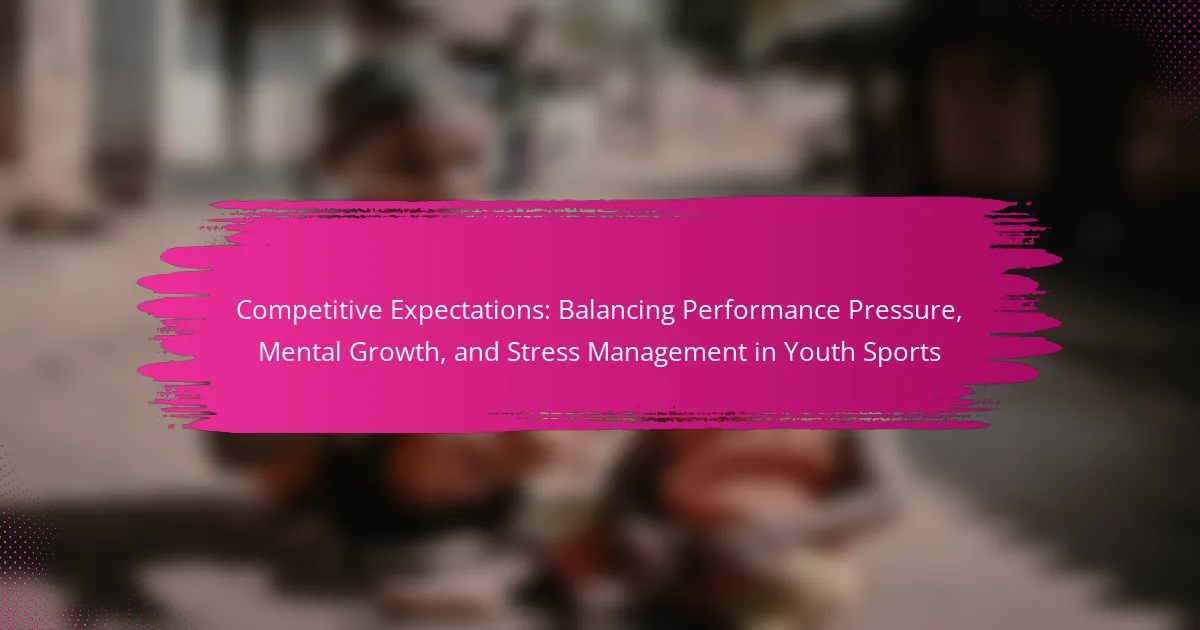Balancing performance pressure in youth sports is essential for fostering mental growth and effective stress management. Competitive expectations can motivate young athletes while also leading to anxiety and burnout. This article explores the impact of performance pressure, the importance of a supportive environment, and strategies for developing coping mechanisms. Emphasizing a growth mindset and open communication can enhance both athletic performance and mental well-being.

How do competitive expectations impact mental development in youth sports?
Competitive expectations can significantly influence mental development in youth sports by creating performance pressure that can enhance or hinder growth. High expectations can motivate young athletes to improve their skills and resilience, fostering a strong work ethic. However, excessive pressure can lead to stress and anxiety, negatively impacting mental health and performance.
Balancing these expectations is crucial. Coaches and parents should encourage a growth mindset, emphasizing effort and learning over winning. This approach helps manage stress and promotes mental well-being, allowing young athletes to thrive.
Research indicates that supportive environments foster better mental development. Athletes who perceive their environment as encouraging are more likely to develop confidence and coping strategies.
In conclusion, competitive expectations shape youth athletes’ mental development, making it essential to balance performance pressure with support and encouragement.
What are the psychological effects of performance pressure on young athletes?
Performance pressure can significantly impact young athletes, leading to anxiety, decreased motivation, and burnout. These psychological effects stem from the high expectations placed on them, which can hinder mental growth. Studies indicate that 50% of young athletes experience stress due to competition, affecting their performance and enjoyment. Effective stress management techniques, such as mindfulness and positive reinforcement, can mitigate these effects, fostering resilience and a healthier attitude towards competition. Balancing performance pressure with mental well-being is essential for sustainable athletic development.
How can competition foster resilience and growth in children?
Competition fosters resilience and growth in children by teaching them to manage stress and build mental toughness. Engaging in competitive sports helps children develop coping strategies, enhancing their ability to face challenges. Research indicates that children participating in competitive environments report improved self-esteem and social skills. Moreover, learning to balance performance pressure can lead to better emotional regulation, which is crucial for growth.
What role does parental involvement play in shaping expectations?
Parental involvement significantly shapes competitive expectations by influencing children’s attitudes toward performance and stress management. Engaged parents foster a supportive environment, promoting healthy mental growth. This involvement can lead to higher self-esteem and resilience in young athletes. Research indicates that children with supportive parents are more likely to set realistic goals and cope with pressure effectively.
How do coaching styles influence mental development?
Coaching styles significantly influence mental development by shaping how young athletes handle performance pressure and stress. Authoritative coaching fosters resilience and adaptability, while overly critical styles can hinder mental growth. Research indicates that positive reinforcement enhances self-esteem, leading to better stress management. Coaches who balance expectations with support cultivate a healthy competitive environment, promoting both performance and psychological well-being.

What are the common stressors faced by young athletes?
Young athletes commonly face stressors such as performance pressure, injury fears, and balancing academics. Competitive expectations create significant mental challenges. These stressors can hinder mental growth and effective stress management.
Performance pressure often stems from coaches, parents, and peers, leading to anxiety. Injuries add another layer of stress, causing worry about recovery and future participation. Balancing academics with sports commitments can overwhelm young athletes, impacting their overall well-being.
As a result, developing coping strategies is essential. Techniques such as mindfulness, time management, and open communication can help athletes navigate these stressors effectively. Recognizing these challenges is crucial for fostering a supportive environment in youth sports.
How do performance anxiety and stress manifest in children?
Performance anxiety and stress in children can manifest as physical symptoms, emotional distress, and behavioral changes. Common indicators include stomachaches, headaches, irritability, and withdrawal from activities. These symptoms often arise from competitive expectations imposed by coaches or parents, leading to a fear of failure.
Children may experience heightened anxiety during competitions, which can hinder their performance and enjoyment of sports. Mental growth is crucial; fostering resilience can help mitigate these effects. Encouraging open communication about feelings and providing support can aid in managing stress effectively.
What are the signs of burnout in youth sports?
Signs of burnout in youth sports include emotional exhaustion, decreased performance, loss of interest, and increased irritability. These symptoms reflect the stress caused by competitive expectations. Youth athletes may also exhibit physical signs such as fatigue and frequent injuries. Recognizing these indicators is essential for effective stress management and mental growth.
How can stress levels vary by sport type?
Stress levels can vary significantly by sport type due to differing competitive expectations and performance pressures. Individual sports, like tennis, often place higher pressure on athletes, leading to increased stress compared to team sports, where support systems may alleviate some pressure. For example, a study found that gymnasts experience unique stress factors related to perfectionism and high expectations, while soccer players benefit from teamwork dynamics that can buffer stress. Understanding these variations is crucial for effective stress management strategies tailored to each sport’s demands.
What is the impact of peer competition on stress levels?
Peer competition significantly increases stress levels in youth sports. This pressure arises from competitive expectations, impacting mental growth and performance. Studies indicate that young athletes often feel heightened anxiety due to the desire to meet peers’ standards. For example, a survey found that 70% of youth athletes reported stress related to competition. Effective stress management techniques, such as mindfulness and goal setting, can help mitigate these effects, promoting healthier athletic experiences.

What unique strategies can help manage stress in youth sports?
To manage stress in youth sports, unique strategies include fostering open communication, promoting a growth mindset, and encouraging balanced participation. These approaches help mitigate performance pressure and enhance mental resilience.
Open communication allows athletes to express their feelings and concerns, reducing anxiety. For example, regular check-ins with coaches can create a supportive environment.
Promoting a growth mindset encourages youth to view challenges as opportunities for learning rather than threats to performance. This shift in perspective can significantly lower stress levels.
Encouraging balanced participation ensures that young athletes engage in various activities, preventing burnout. Diverse experiences contribute to holistic development, fostering both physical and mental growth.
How can mindfulness techniques be applied in sports training?
Mindfulness techniques enhance sports training by promoting focus, reducing anxiety, and improving overall mental resilience. These practices help young athletes manage performance pressure effectively. Techniques such as deep breathing and visualization enable athletes to stay present, fostering a balanced mindset. Integrating mindfulness into training routines can lead to improved concentration and a more positive attitude towards competition. As a result, youth athletes experience mental growth and better stress management, ultimately enhancing their performance.
What role do relaxation techniques play in performance?
Relaxation techniques significantly enhance performance by reducing stress and improving focus. These methods, such as deep breathing and visualization, help young athletes manage competitive pressure effectively. As a result, athletes experience improved mental clarity, which translates into better decision-making during competitions. Studies show that consistent use of relaxation techniques can lead to a measurable increase in performance metrics, making them a unique asset in youth sports training.
How can goal-setting reduce performance anxiety?
Goal-setting effectively reduces performance anxiety by providing structure and clarity. Establishing specific, measurable objectives allows young athletes to focus on achievable tasks rather than overwhelming expectations. This approach enhances confidence and promotes mental growth, which are essential for managing stress in competitive environments. Research indicates that athletes who set clear goals experience lower anxiety levels and improved performance outcomes. By prioritising personal development over external pressures, youth can cultivate resilience and maintain a healthier perspective on competition.
What are effective communication strategies between coaches and young athletes?
Effective communication strategies between coaches and young athletes include fostering an open dialogue, setting clear expectations, and providing constructive feedback. Coaches should encourage athletes to express their thoughts and feelings, creating a supportive environment. Setting specific performance goals helps athletes understand what is expected, balancing pressure with achievable targets. Constructive feedback should focus on improvement rather than criticism, promoting mental growth and resilience. Regular check-ins can help manage stress and ensure athletes feel valued and understood.

What are the best practices for balancing performance pressure and mental growth?
To balance performance pressure and mental growth, youth athletes should prioritise self-awareness, set realistic goals, and practice stress management techniques. Engaging in regular reflection on their performance helps maintain perspective. Additionally, fostering a supportive environment encourages open communication about challenges and achievements. Incorporating mindfulness practices can enhance focus and resilience, ultimately promoting both performance and mental well-being.
How can coaches create a supportive environment for young athletes?
Coaches can create a supportive environment for young athletes by prioritising mental growth alongside performance. They should establish open communication, encourage a growth mindset, and promote teamwork.
Regular feedback helps athletes understand their progress, while celebrating small achievements fosters motivation. Coaches should also educate athletes on stress management techniques, such as mindfulness and relaxation exercises, to handle competitive pressure effectively.
Incorporating team-building activities strengthens relationships and builds trust, creating a cohesive and supportive atmosphere. Ultimately, fostering a culture that values effort over outcome cultivates resilience and long-term development in young athletes.
What are the core features of effective stress management programs in sports?
Effective stress management programs in sports focus on enhancing mental resilience, providing coping strategies, and fostering a supportive environment. Key features include education on stress awareness, techniques for relaxation and mindfulness, and individualized support systems. Programs often incorporate goal-setting to balance competitive expectations with personal growth. Regular feedback and open communication promote a culture of trust, enabling young athletes to thrive under pressure. These elements collectively contribute to improved performance and overall well-being in youth sports.
How can parents support their children’s mental health in sports?
Parents can support their children’s mental health in sports by fostering a balanced approach to performance expectations. Encourage open communication about feelings and challenges.
Promote enjoyment over winning to reduce pressure. Help set realistic goals that prioritize personal growth. Teach stress management techniques, such as mindfulness or breathing exercises.
Recognize signs of burnout or anxiety, and be ready to adjust involvement accordingly. Provide a supportive environment that values effort and resilience.
Engage in discussions about the importance of mental health, emphasizing that it is as crucial as physical performance.
What are common mistakes to avoid in youth sports coaching?
Common mistakes in youth sports coaching include imposing unrealistic competitive expectations, neglecting mental growth, and failing to manage stress effectively. Coaches should prioritize skill development over winning, encourage a growth mindset, and create a supportive environment. Balancing performance pressure with emotional well-being fosters resilience in young athletes.
What expert insights can help optimize mental development in young athletes?
Expert insights emphasize the importance of balancing performance pressure with mental growth in young athletes. Strategies include fostering a supportive environment, promoting open communication, and teaching stress management techniques. Research indicates that athletes who receive constructive feedback and encouragement exhibit better mental resilience and performance outcomes. Incorporating mindfulness practices can significantly enhance focus and reduce anxiety, ultimately leading to improved athletic performance and personal development.


